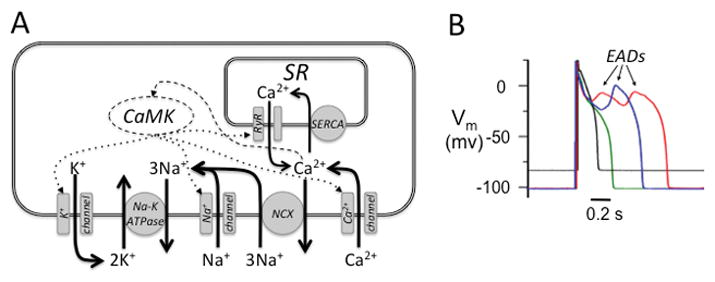Figure 1.

A. Interconnectedness of K+, Na+ and Ca2+ balances in the cardiac myocyte. Outward K+ loss through K+ channels (left) is recovered by the Na+-K+ ATPase removing 3 Na+ ions in exchange for 2 K+ ions. Some Na+ ions enter the cell via Na+ channels, but most via Na+-Ca2+ exchange (NCX) during diastole, which exchanges 1 Ca2+ ion for 3 Na+ ions. In the steady state, the Ca2+ removed by NCX balances the Ca2+ entering the cell via Ca2+ channels. Most Ca2+ in the cell recycles between the sarcoplasmic reticulum (SR) and cytoplasm, with uptake by sarco-endoplasmic reticulum Ca2+ ATPase (SERCA) and release through ryanodine receptors (RyR). Cytoplasmic free Ca2+ activates CaMK, which regulates the properties of Na+, Ca2+ and K+ channels, and RyR in the SR (dotted arrows). B. Effects of hypokalemia on the AP. Superimposed AP recordings from an isolated rabbit ventricular myocyte with [K+]o=5.4 mmol/l (black trace) versus [K+]o= 2.7 mmol/l (red trace), showing hyperpolarized Em and EADs, the latter suppressed by the CaMK blocker KN-93 (green trace), but not by inactive KN-92 (blue trace). Modified from Pezhouman et al2 with permission.
